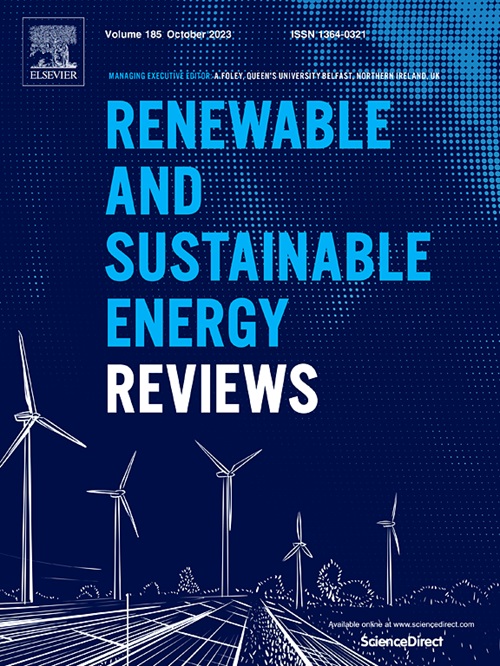能源转型视角下大气污染对健康经济的影响研究——以中国长三角地区为例
IF 16.3
1区 工程技术
Q1 ENERGY & FUELS
引用次数: 0
摘要
在绿色能源转型下,空气质量改善带来的健康效益可以大大抵消转型成本。因此,评估环境健康协同效益对于优化过渡途径至关重要。然而,现有研究往往缺乏将能源转型与卫生经济学联系起来的定量评估框架,同时忽视了区域差异、部门异质性和精细的情景设计。因此,开发了一个新的多区域、多部门综合评估框架,将能源转型战略、空气污染物排放、公共卫生结果和与健康相关的经济效益联系起来。该框架建立在长期能源替代规划平台上,结合了暴露-响应原则和利益转移估计方法。在此基础上,结合多元回归分析、自回归综合移动平均模型和Gompertz函数,构建了1个基线和4个能源转型子情景,并对长三角地区2020 - 2030年的空气质量改善、公共健康效益和经济效益进行了评价。主要发现包括:(1)综合能源转型情景可带来显著的初级PM2.5减排、健康协同效益和健康经济效益,其中江苏面临的健康影响最大;(2)上海交通部门贡献最大,其他地区以工业和交通部门为主,安徽生活部门增长显著;(3)提高能源效率的协同效益最大,其次是交通运输优化和产业结构调整,而清洁能源部署在江苏效果显著,其他地区影响有限。这项研究为促进环境和公共卫生目标的特定区域和针对部门的能源转型政策提供了方法学见解和定量支持。本文章由计算机程序翻译,如有差异,请以英文原文为准。
Study on the impact of air pollution on health economy under the perspective of energy transition: A case of the Yangtze River Delta region in China
Under the green energy transition, health benefits from improved air quality can substantially offset transition costs. Therefore, evaluating environmental health co-benefits is crucial for optimizing transition pathways. However, existing studies often lack a quantitative assessment framework linking energy transitions to health economics, while overlooking regional disparities, sectoral heterogeneity, and refined scenario design. Accordingly, a novel multi-regional, multi-sector integrated assessment framework that connects energy transition strategies, air pollutant emissions, public health outcomes, and health-related economic benefits is developed. The framework builds on the Long Range Energy Alternatives Planning platform, combined with the exposure-response principle and a benefit-shifting estimation method. Furthermore, incorporating multiple regression analysis, an auto-regressive integrated moving average model, and Gompertz functions, one baseline and four energy transition sub-scenarios are constructed, following which air quality improvements, public health benefits, and economic gains in the Yangtze River Delta region between 2020 and 2030 is evaluated. Key findings include: (1) the integrated energy transition scenario delivers significant primary PM2.5 emissions reductions, health co-benefits, and health economic benefits, with Jiangsu facing the largest health impacts; (2) Shanghai's transport sector contributes most, while the industrial and transport sectors dominate in other regions, and Anhui's living sector exhibits notable growth; (3) improving energy efficiency offers the greatest co-benefits, followed by transport optimization and industrial restructuring, while clean energy deployment shows significant effects in Jiangsu but limited impacts elsewhere. This study provides methodological insights and quantitative support for region-specific and sector-targeted energy transition policies that promote environmental and public health goals.
求助全文
通过发布文献求助,成功后即可免费获取论文全文。
去求助
来源期刊

Renewable and Sustainable Energy Reviews
工程技术-能源与燃料
CiteScore
31.20
自引率
5.70%
发文量
1055
审稿时长
62 days
期刊介绍:
The mission of Renewable and Sustainable Energy Reviews is to disseminate the most compelling and pertinent critical insights in renewable and sustainable energy, fostering collaboration among the research community, private sector, and policy and decision makers. The journal aims to exchange challenges, solutions, innovative concepts, and technologies, contributing to sustainable development, the transition to a low-carbon future, and the attainment of emissions targets outlined by the United Nations Framework Convention on Climate Change.
Renewable and Sustainable Energy Reviews publishes a diverse range of content, including review papers, original research, case studies, and analyses of new technologies, all featuring a substantial review component such as critique, comparison, or analysis. Introducing a distinctive paper type, Expert Insights, the journal presents commissioned mini-reviews authored by field leaders, addressing topics of significant interest. Case studies undergo consideration only if they showcase the work's applicability to other regions or contribute valuable insights to the broader field of renewable and sustainable energy. Notably, a bibliographic or literature review lacking critical analysis is deemed unsuitable for publication.
 求助内容:
求助内容: 应助结果提醒方式:
应助结果提醒方式:


